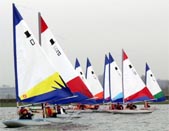 |
The Official
|
| www.sailing.org |
17 February 2004, 10:15 am
Centre Mainsheet Introduced

Testing the Centre Main Sheet © International Topper Class
International Topper Class
Approved by ISAF in November 2003, a recent rule change by the Topper Class now allows the popular single-handed dinghy to be fitted with a centre mainsheeting system.
International Topper Class Association Chairman Martin SMITH commented, "We know that the majority of dinghies have centre-mains, this change will be better for everybody, sailors, sailing schools and aspiring Olympic champions to enjoy this versatile dinghy. For sailing schools they will only need to teach one technique for tacking, and for those early starters on the fast track to the Olympic classes there will be no need to switch between aft and centre mains".
Roger PROCTOR, son of the designer and Director of Ian PROCTOR Designs, added "This change will keep the Topper in its pre-eminent position as both a family dinghy and competitive one design fleet racing dinghy".
Only two holes need to be drilled by the daggerboard to fit the new system, and the rules even allow switching between centre and aft systems during a regatta. No holes need to be drilled in the boom. Tests conducted by the Class have confirmed that no performance differences between the two systems were measured.
The manufacturers, Topper International Limited, will be shipping the system as an option on new boats, with conversion packs being available for the current fleet.

© D Cockerill
The centre-main system is an optional change from the standard aft sheeting. Sailors may choose to change between the centre-main and aft-sheeting systems at any time. If they choose to use the centre-main sheeting system:
1. The centre sheeting system must follow the general arrangement set out above.
2. A turning block, which may be a ratchet block, will be attached to a stainless steel lacing eye. This lacing eye is to be attached to the top of the daggerboard case moulding with nuts and bolts that pass through the deck and hull with the thread coming through from the inside. The eye is to be mounted at right angles to and equi-distance either side of the centre-line of the boat +/- 2mm. The distance between the most rear point of the daggerboard slot in its original shape and the centre-line of the lacing eye must be between 8 and 14mm. The centres of the holes in the lacing eye must be between 30 and 40mm.
3. A turning block will be attached to the boom using a webbing strap. The distance between the centre of the pivot of the block and the centre of the rivet attaching the stainless steel strap to the boom will be 130mm +/- 50mm. This measurement to be taken whilst the mainsheet is pulled tight through the last turning block.
4. A loop made of sailcloth or webbing will be attached to the boom with Velcro. The centre-line of the loop must be 1250mm +/- 25mm from the aft face of the mast. The loop must be 130mm +/- 25mm wide and must hang a maximum of 50mm below the lower surface of the boom when the sailcloth is pulled tight.
5. No additional holes may be drilled through the boom.
© 2015 Copyright ISAF/ISAF UK Ltd. All Rights Reserved Privacy & Cookies delivered by Sotic powered by OpenText WSM













